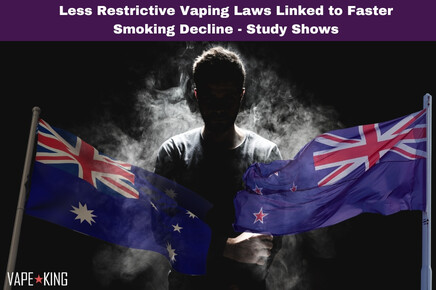Free Shipping on orders R1000 or more!
Less restrictive vaping laws linked to faster smoking decline

Recent research from the University of Queensland suggests that less restrictive vaping regulations could significantly improve public health by accelerating the decline in smoking rates. The study found that New Zealand’s smoking rates have declined at twice the rate of Australia’s, highlighting the potential benefits of a more accessible vaping model.
Vaping and Smoking Decline: The Numbers
Emeritus Professor Wayne Hall from UQ’s National Centre for Youth Substance Abuse Research reported that New Zealand’s adult daily smoking rates dropped by 10% per year between 2016 and 2023, whereas Australia’s declined by only 5% annually. This trend closely aligns with vaping prevalence—9.7% of New Zealand adults vaped daily in 2023, compared to just 3.5% in Australia.
The Impact of Vaping Regulations
Australia enforces a highly restrictive, medical-only model for vaping products, making access challenging. In contrast, New Zealand has embraced vaping as a harm reduction tool, allowing regulated sales through licensed retailers—an approach similar to that of the UK, USA, and Canada.
Professor Hall emphasized that increasing access to regulated nicotine vaping products could improve public health, reduce social inequalities, and curb the illicit vape market.
“Tobacco smoking remains the leading preventable cause of death and disease in both Australia and New Zealand,” he said. “Our research indicates that smoking is declining most rapidly among younger adults, the group with the highest vaping rates.”
The study also found that New Zealand’s most disadvantaged populations—who traditionally have high smoking rates—experienced the most significant declines in smoking, further reinforcing the role of vaping as a harm reduction tool.
The Unintended Consequences of Restrictive Policies
Co-author Associate Professor Gary Chan noted that Australia’s strict vaping laws may have inadvertently fueled a thriving black market, which now supplies over 90% of vaping products.
“Vaping regulations must strike a balance—reducing youth access while ensuring adult smokers have the opportunity to switch to a less harmful alternative,” Chan said.
The study suggests that a regulated retail model, such as New Zealand’s, could introduce safeguards to prevent youth uptake, including restricting sales to licensed retailers, enforcing strict age verification, banning flavor names and imagery targeting young people, and limiting advertising exposure to adolescents.
A Path Forward for Public Health
Professor Ron Borland from Deakin University’s School of Psychology highlighted the potential benefits of adopting a more permissive vaping model.
“If vaping is driving the rapid smoking decline in New Zealand, these findings suggest that allowing regulated retail sales while positioning vapes as a better alternative could be more effective in reducing smoking rates, particularly among high-risk groups,” he said.
Adopting a similar approach in Australia could accelerate smoking reduction, improve public health, decrease health disparities for disadvantaged and Indigenous communities, and help eliminate the illicit vape trade.
The research has been published in Addiction (view the study here) and adds to the growing body of evidence supporting vaping as a harm reduction strategy.
At Vape King, we believe in responsible vaping practices and advocate for fair regulations that prioritize both harm reduction and public health.
No posts found
Write a review

